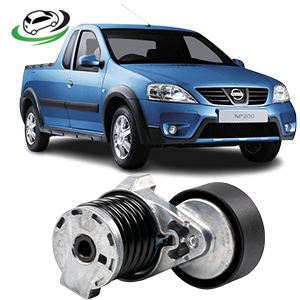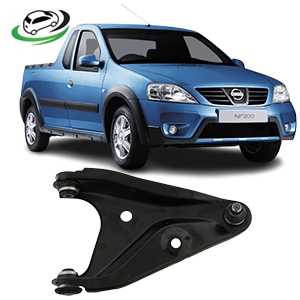-10%
Get Nissan Pick Up NP200 Front Suspension Lower Arm Assy RH 54500-00QIF
The front suspension lower arm assembly on the right-hand side (RH) of the Nissan NP200 is a vital component that contributes significantly to the vehicle’s ride comfort, handling, and overall suspension geometry. Commonly referred to as the control arm, this part connects the chassis to the wheel hub and allows the wheel to move vertically, absorbing shocks from the road while maintaining proper wheel alignment. This guide provides a detailed, 1000-word explanation of the right-hand front lower arm assembly, covering its design, function, benefits, common issues, and maintenance.
1. Understanding the Lower Arm Assembly
The lower arm assembly, often referred to as a control arm, is part of the front suspension system that links the wheel hub to the vehicle’s chassis. It is responsible for controlling the up-and-down motion of the wheel in relation to the road, allowing for smooth ride quality and consistent handling. The lower control arm operates in conjunction with other suspension components such as the shock absorbers, upper control arms, and stabilizer bar to provide stability and ride comfort.
The front lower arm on the right-hand side (RH) of the Nissan NP200 consists of a few key parts:
- Control Arm Body: The main structure of the arm, usually made from stamped steel or cast aluminum, which provides strength while keeping the weight low.
- Ball Joint: A spherical joint that connects the control arm to the wheel hub. It allows for smooth pivoting motion as the suspension moves up and down.
- Bushings: Rubber or polyurethane bushings that connect the arm to the chassis. These bushings help absorb vibrations and road impacts, providing smoother motion while reducing wear on other suspension components.
2. Function of the Lower Arm Assembly
The front suspension lower arm assembly serves several critical functions that contribute to the vehicle’s overall handling and comfort:
- Connecting the Wheel to the Chassis: The control arm physically links the chassis to the wheel hub. This connection ensures that the wheel can move vertically while staying in line with the chassis for proper alignment and stability.
- Absorbing Road Impact: The control arm works with the shock absorbers and struts to absorb shocks and vibrations from road imperfections such as potholes and bumps. By controlling the up-and-down motion of the wheel, it prevents these impacts from being transferred directly to the vehicle’s body, providing a smoother ride for passengers.
- Maintaining Alignment and Stability: The control arm plays a key role in maintaining proper wheel alignment and suspension geometry. By keeping the wheel hub positioned correctly in relation to the chassis, it ensures that the wheel’s camber and caster angles remain optimal. Proper alignment enhances vehicle stability, improves tire wear, and allows for more predictable steering responses.
- Providing Pivot Motion: The ball joint at the end of the control arm allows the wheel to pivot as the suspension moves up and down. This pivoting action helps to maintain a stable driving experience, even on uneven road surfaces.
3. Importance of the Right-Hand Lower Arm in the Suspension System
The lower control arm on the right-hand side is particularly important because it ensures that the suspension system on that side of the vehicle performs optimally. Together with the left-hand side, the lower arms balance the load and forces experienced by the front suspension. If one side (such as the RH arm) becomes damaged or worn, it can throw off the vehicle’s alignment, leading to uneven tire wear, poor handling, and increased strain on other suspension components.
4. Common Issues with the Front Lower Arm Assembly
Like all suspension components, the front lower arm assembly is subject to wear and tear over time, especially if the vehicle is driven on rough roads or under heavy loads. Some of the most common issues with the front RH lower arm on the Nissan NP200 include:
- Worn Bushings: The rubber bushings that connect the lower arm to the chassis can degrade over time due to exposure to heat, moisture, and road debris. Worn bushings can cause clunking noises, poor handling, and excessive vibration in the steering wheel.
- Ball Joint Failure: The ball joint allows the wheel hub to pivot in relation to the control arm. Over time, the ball joint can wear out, leading to steering problems, a loose or wandering feeling in the steering, and uneven tire wear. In extreme cases, a failed ball joint can cause the wheel to separate from the vehicle, posing a serious safety risk.
- Bent or Damaged Control Arm: The control arm itself can become bent or damaged due to impacts from potholes, curbs, or collisions. A bent arm can affect wheel alignment, causing the vehicle to pull to one side and leading to uneven tire wear and poor handling.
- Corrosion: Depending on the environment in which the vehicle is used, corrosion can become an issue, particularly in regions where road salt is used in the winter. Rust can weaken the structural integrity of the control arm, making it more susceptible to failure.
5. Symptoms of a Failing Front Lower Arm Assembly
A failing or damaged front lower arm assembly will often exhibit several warning signs. If you experience any of these symptoms on your Nissan NP200, it may indicate an issue with the RH lower control arm:
- Clunking or Knocking Noise: A worn ball joint or bushings can cause a clunking noise, particularly when going over bumps or making turns. This noise occurs when the worn-out components allow excess movement in the suspension.
- Poor Handling: If the control arm or its components are worn, you may notice that the vehicle’s handling becomes less predictable. The vehicle might feel loose or unstable, especially during cornering.
- Uneven Tire Wear: A bent control arm or a worn ball joint can cause the wheel alignment to be thrown off. This misalignment leads to uneven tire wear, which can be visible on the inner or outer edges of the tire tread.
- Steering Vibration: Worn bushings or a failing ball joint can cause excessive vibrations in the steering wheel, especially when driving at higher speeds or over rough roads.
6. Maintenance and Replacement of the Lower Arm Assembly
To ensure the longevity of the front RH lower arm assembly, regular maintenance and inspection are essential. Some key maintenance tips include:
- Regular Inspection: During routine servicing, inspect the control arm, bushings, and ball joint for any signs of wear or damage. Pay attention to any unusual noises or changes in handling that could indicate a problem.
- Replace Worn Bushings: If the bushings are worn or cracked, replace them as soon as possible to avoid excessive movement in the suspension and to prevent further damage to the control arm and ball joint.
- Ball Joint Replacement: A worn ball joint should be replaced immediately, as failure can lead to catastrophic suspension failure and loss of vehicle control.
- Alignment Check: After any suspension repair or component replacement, it’s crucial to have the vehicle’s alignment checked and adjusted if necessary. Proper alignment will help prevent uneven tire wear and ensure optimal handling.
7. Replacing the Front RH Lower Arm Assembly
Replacing the front lower arm assembly on the right-hand side of the Nissan NP200 requires some technical knowledge and mechanical tools. Here’s an overview of the replacement process:
- Lift the Vehicle: Use a jack and secure the vehicle on stands to safely access the front suspension.
- Remove the Wheel: Take off the front right wheel to expose the control arm and suspension components.
- Disconnect the Ball Joint: Use a ball joint separator to disconnect the ball joint from the steering knuckle.
- Unbolt the Control Arm: Remove the bolts securing the control arm to the chassis and subframe. Take care to note the placement of any washers or spacers.
- Install the New Control Arm: Position the new lower arm assembly and secure it with the appropriate bolts, ensuring they are torqued to the manufacturer’s specifications.
- Reconnect the Ball Joint: Reattach the ball joint to the steering knuckle and tighten the nut securely.
- Reinstall the Wheel: Put the wheel back on and lower the vehicle.
- Perform Alignment: After replacing the control arm, take the vehicle for a professional alignment to ensure everything is properly aligned.
8. Conclusion
The front suspension lower arm assembly (RH) of the Nissan NP200 is a crucial part of the vehicle’s suspension system. It connects the wheel to the chassis, ensuring proper alignment, stability, and ride comfort. Regular maintenance, timely replacement of worn components, and proper installation of new parts are essential for keeping the suspension system functioning optimally. By paying attention to the symptoms of a failing control arm and addressing issues early, you can avoid more severe suspension problems and maintain the safety and handling performance of your Nissan NP200.
Follow us on Facebook for more parts.



